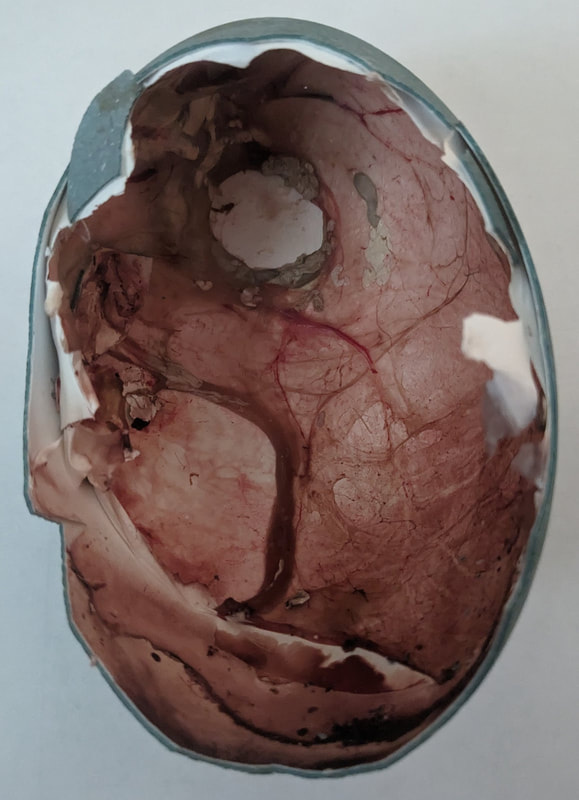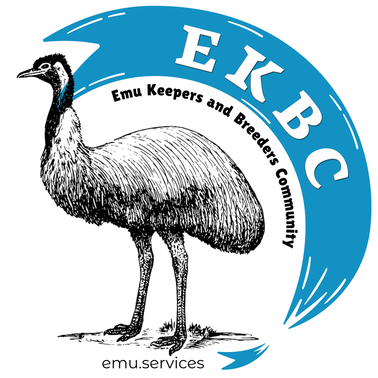Should you drill a hole in the emu egg or Not?Thanks go to Alex Walker for the article. OK, I’ve read several posts lately in different Emu groups about the hatching process of Emu, it’s probably the only time that we humans think we can interfere to "help", either by drilling small holes in the air cell end of the shell or breaking away parts of the shell to “assist" the baby chick get out. Therefore, I thought I’d go through the actual process of a baby Emu (or other chick) hatching. Depending on the species, the chick will orientate itself in the hatching position a few days before hatching. To do this the chick wriggles around inside the shell and gets its head under its left wing. At the same time this is happening the egg shell which is made up of three layers of crystalline calcium with minerals in a Nano structure is being dissolved, from the inside out by a protein called 'osteopontin' which takes this calcium into the membrane surrounding the chick and through that, into the chicks bloodstream. The calcium is then absorbed into the chicks skeleton strengthening the chicks bones, like you taking calcium tablets! This process weakens the shell layers from the inside out making pipping and hatching easier. The membrane called the chorioallantois has been allowing the chick to inhale oxygen from outside, and exhale carbon dioxide from the chick through the shell pores (the lighter coloured specs on the eggs). This membrane is full of tiny blood vessels that transport the oxygen through the shell and into the chick. A couple of days before hatching (in Emu), the chick breaks through the internal wall into the air cell end of the egg (internally pips), and starts breathing air through its lungs, as well as still being attached to the membrane via an umbilicus. At the same time a muscle on the back of the chicks neck enlarges several times it original size to form a 'pipping muscle'. The chick then continues to breathe the air in the air cell whilst getting ready for the big push. At the same time the movements inside the shell are helping the yolk sac to be absorbed into the abdomen, sometimes this is only complete right before hatching. As the air in the air cell gets used up the chick starts to 'suffocate', oxygen is running out and carbon dioxide levels in its blood increase dramatically, this TRIGGERS the pipping muscle which will involuntary to go into spasm, it starts to flex causing the beak to strike the weakened shell from the inside. When the spasms become strong enough the chick breaks through the three layers of shell into the big wide world and can take a breath of fresh air and recover from a very traumatic (near death) experience. After resting, sometimes for several hours, it continues to enlarge the hole, and it’s struggles help the last remaining yolk sac to be absorbed, also, the stress and exhaustion of hatching strengthens the lungs and blood system. Only towards the end of hatching does it detach itself from the membrane that is full of blood vessels, If the membrane and blood vessels are dried from premature drilling it can be fatal at the time of releasing from the membrane, For the above reasons you can see why - 1) You shouldn’t interfere by drilling holes in the shell. 2) You shouldn’t start breaking bits of shell away to make the hole bigger as you risk breaking a blood vessel and causing the chick to bleed to death. The images here show the chick in the egg, with the membrane and blood vessels.
It is important that we don't pick at the shell or membrane as the membrane may be still attached to the chick. The membrane in an Emu egg is not the same as that of poultry and it doesn’t need a high humidity on hatching. The baby Emu is also SO POWERFUL that it can burst through one of the strongest egg shells there are, so it just bursts the dry membrane away! Emu do not 'shrink wrap' like other species, they do not have an egg tooth either, so emu chicks do not pip a hole with an egg tooth and unzip themselves from the egg. So, please read and take this on board. Unfortunately, much like other animals and birds, some don’t make it due to not being healthy and strong enough. This doesn’t mean that if you’d drilled a hole you’d get a healthy strong chick. And for people who did drill a hole and get a chick, it may have hatched normally anyway. Unfortunately eggs are expensive and no one wants a loss, but one thing the emu world doesn’t need is future breeding emus that struggled health wise. The stronger and healthier the chick, the higher chance that it’s own chicks will be too. A short video showing an emu part the way out of an egg.
Recommended further reading.
This is a very interesting article explaining the same emu hatch process... https://www.patreon.com/posts/emu-eggs-part-2-35048141 Also, Circulatory changes associated with the closure of the ductus arteriosus in hatching emu (Dromaius novaehollandiae)
0 Comments
Your comment will be posted after it is approved.
Leave a Reply. |
Details
Articles written for the website by anyone who would like to share information on keeping and raising emu, emu care, emu health and disease management, raising chicks, emu behaviour etc.
Archives
April 2024
Categories
All
|
|
Please feel free to share or quote anything from this website. In doing so please link or reference this website, address... www.emu.services
|
|

 RSS Feed
RSS Feed
